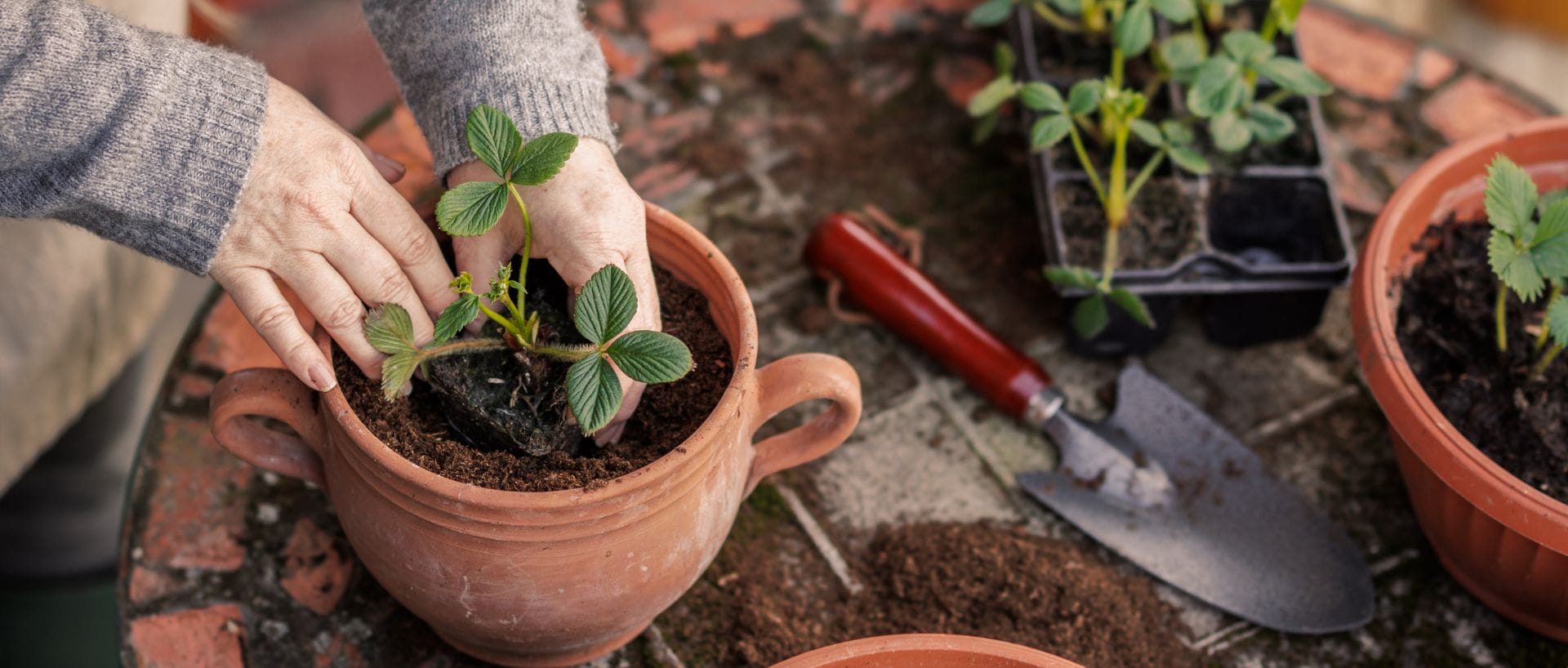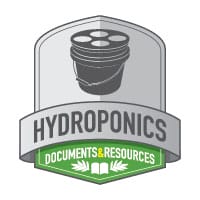In the world of indoor gardening, we often hear the question –
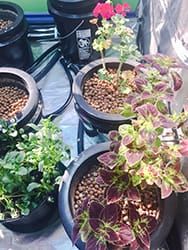
“What is the best hydroponic technique?”
The answer here is almost certainly subjective, but also a matter of circumstance in part. With so many methods of hydroponic growing to choose from, there isn’t necessarily any one-size-fits-all answer. However, we usually find ourselves referring to the ebb and flow technique first when this question comes up. In this week’s Talking Shop we’ll cover the ins & outs of ebb & flow including, method benefits and system types, as well as tips for operating and getting the most out of your system. And of course – be sure to read through for our coupon code of the week!
What is Ebb and Flow?
Ebb and Flow or “flood and drain” is an effective, relatively low-cost, and very versatile hydroponic system, which makes it great for beginners and pros alike. Systems come in several shapes and sizes and can be used for the early stages of vegetative growth all the way through harvest.
The mechanics are simple: A hydroponic ebb and flow system works by periodically pumping nutrient-rich solution to the plant sites once, or more often, several times a day. This flooding (the ‘flow’) meets the nutritional needs of your plants by saturating the grow medium with solution. After the mediums have been saturated, the pumps are stopped, and the ‘ebb’ process begins. The ebb is the draining of the solution back to the reservoir. This period in between the flood cycles creates a well aerated and moist environment where your roots, and thus your plants, will thrive.
The ebb and flow system cycles are accomplished with just a few simple hydro components including a central reservoir, a flood tray or modules (buckets), submersible pump(s), timer(s), and sometimes float valves or overflow drains. In most systems, float valves or overflow drains prevent overfilling, while one or two timers control the intervals at which your nutrient reservoirs flood and drain the solution (typically multiple times throughout the day). This straightforward setup with a minimal number of components not only simplifies feeding but also creates a highly effective method of nutrient delivery and root aeration.
Flood and Drain System Types
Flood Tables – Typically a flood table is a large plastic “flood tray” positioned over a reservoir that holds the nutrient solution and pump. Flood and drain table systems are ideal for both vegetative stage transplants and smaller finished plants including those that are forced to bloom at a young age (i.e. Sea of Green or SOG method). They can also be used in a number of different ways. For instance, the entire flood tray could be filled with the medium and the plants can be placed directly in the medium. While practical for some purposes, this isn’t ideal in general because plants can’t be moved/repositioned when planted in this manner. The most common method is to place plants in individual containers or rockwool cubes in the tray. In this case, the grow medium soaks up the nutrient solution as the table floods. Most flood tables feature a single submersible pump that is placed in the reservoir and operated on a timer to periodically flood the tray.

After the flood cycle is complete, the pump shuts off and the nutrient solution flows back into the reservoir back through the pump via gravity. For this reason, the flood tray must be placed above the reservoir. Whether your flood tray is positioned on a stand/table or directly on top of the reservoir, one thing to keep in mind is that the tray needs to be level so that the plants are irrigated evenly and the system drains properly. Another important feature of flood table hydroponic systems is the overflow drain, which controls the height of the fill and prevents the tray from spilling over.
DIY Flood Table Systems
HTG Supply offers many different sizes of hydroponics flood trays for you to choose from, the most popular sizes being 4’ x 4’ and 2’ x 4’. If you’re interested in going the DIY hydroponics route, there are a couple things to consider when shopping for your parts. First, be sure that your reservoir is large enough to fill your tray to the correct level. This calculation will help you make sure you get it right:
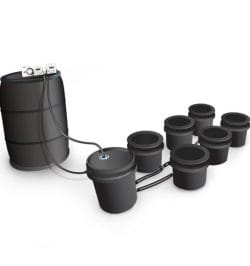
L” x W” x D” x 0.0043 = Gallons needed for flood table
L –> Length of Flood Table (in Inches)
W –> Width of Flood Table (in Inches)
D –> Depth of water desired for Flood cycle (in inches)
Say, in our case, we’re using a 2′ x 4′ (48″ x 24″) flood table and we want to fill the table with at least 3 inches of water. Our equation is (48 x 24 x 3 x 0.0043 = 14.8608).
According to the math, we need just about 15 gallons of nutrient solution to adequately flood the 2′ x 4′ table to 3″ (not factoring displacement). Knowing this, we need to choose a reservoir that holds more than 15 gallons to account for the plant nutrient intake and evaporation.
Making sure your submersible pump is up to the task is also important, and the general rule is that your fill cycle should take around 5 minutes or less (note – digital timers that offer smaller time increments work best). There’s also a similar calculation to determine pump gallon per hour (GPH) requirements:
L’ x W’ x 1.25 x 10 = GPH for proper fill times
Essentially we take the square foot measurement of the table, add 25%, and multiply by 10. Using the same measurements above our minimum rating comes out to 100 gph (2 x 4 x 1.25 x 10). Note: It’s also important to factor in how high above the reservoir your table will be positioned. Pump flow will decrease as vertical pumping distance increases so be sure to check pump specifications for gph flow for the height measurement between the reservoir and table.
Finally, it should also be noted that when you’re installing fill and overflow drain tubing/fittings, the overflow drain should be larger in diameter than the inlet, i.e., a system with a ½” fill line should have a ¾” drain line. Our recommendation is to pick up an appropriately sized flood and drain kits that make this step easy.
Modular Ebb and Flow or Bucket Systems
Modular Ebb and flow or bucket systems feature individual planting sites, usually buckets, positioned (generally) on the floor of the growing area. Modules can be planted in various ways and with a variety of grow mediums. Some systems utilize liners similar to a fabric grow pot that fills the entire volume of the site, while others feature bucket lids with built-in net pots like those used in many other hydroponic system types.
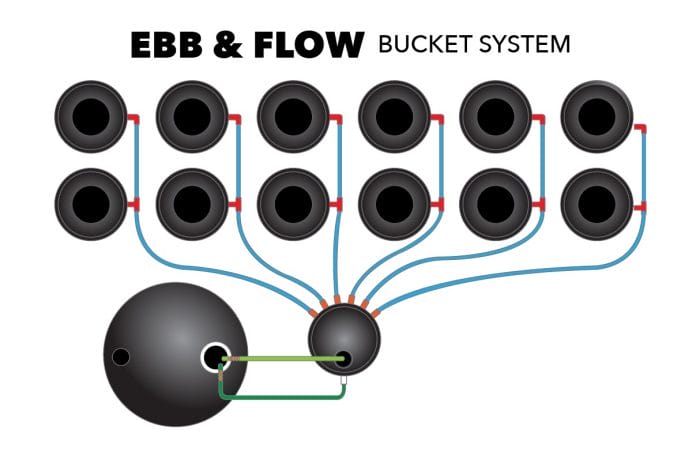
The concept of modular systems is essentially the same as the flood table. Grow buckets (modules) are filled with nutrient solution from the main reservoir via a submersible pump that operates on a timer. In this case though, the solution passes through a control bucket that is connected to each individual grow bucket. As the grow buckets fill, a float valve in the control bucket regulates the water level to prevent spillage. Because modular systems are made to sit directly on the floor, they don’t have the benefit of using gravity to drain the system. Instead, they require a second pump positioned in the control bucket to return the nutrient solution to the reservoir. After the flood cycle is complete, a timer activates the control bucket pump, which returns the solution in the control/site buckets back to the reservoir where the cycle starts over.
Although they basically work the same way as flood tables, modular systems are a better option if you intend to grow larger plants because they provide the maximum amount of vertical growing room and more space for root development. Grow buckets can also be positioned in many different patterns to best fit the grow space and the lights being used. As an added bonus, the site mobility of modular systems also makes regular cleaning a little easier. Plants can be moved out of the system, and into placed into holding buckets during maintenance.
How to Use Flood and Drain Hydroponic Systems
The ebb and flow of the nutrient solution in a flood and drain system is intended to maximize the absorption of hydroponic nutrients and oxygen in the root zone for faster growth and higher yields. Basically, water and air don’t occupy the same space at the same time in the medium, and because of this, we use the timing of irrigations to find an optimal balance between the air and water content of the medium over time. Too much irrigation can compromise aeration; too few irrigations, and there will not be enough solution stored in the medium between irrigations to maintain an adequate water and nutrient supply.
Whether you’re using a flood table or a modular system, there are 3 main factors that will affect the frequency or number of times per day you need to run the flood and drain cycles – container size, plant size, and water-retention characteristics of the grow medium. The first one there is a bit of a no-brainer, and of course, bigger plants consume more nutrient solution so this cycle frequency will need to be ramped up as your plants grow larger. Adjusting for different grow medium types is more variable because there are countless medium mixing options, but it still follows a basic principle. Softer mediums like rockwool will hold more moisture while hard mediums like expanded clay pellets or stone will hold very little. While we can’t chart every potential combination, the chart below illustrates general flooding schedules throughout the grow cycle for a few of the most common grow medium types.
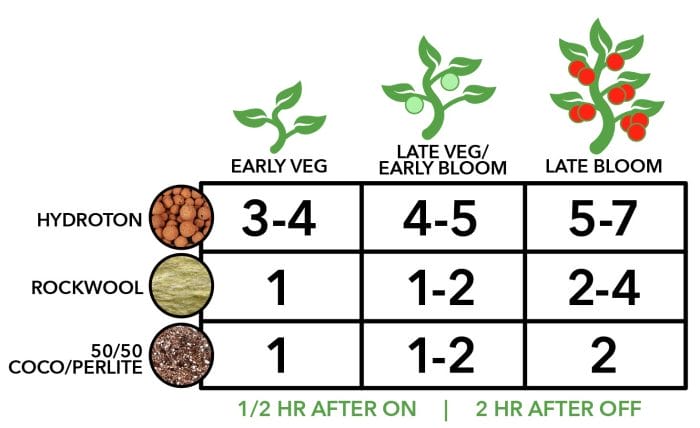
Choosing a Medium – It really comes down to personal preference when choosing a grow medium for your flood and drain system. The main thing to keep in mind is that your substrate should be inert like expanded clay, coco coir, stones, or rockwool (no soil/compost mixes). These mediums will provide the roots stability and the optimal air to moisture content for proper growth.
Ebb & Flow Tips
After you’ve decided which system type and medium you’re going to grow with, tested your setup, and determined a good cycle schedule to start with, the rest of the work will involve adjusting the flood and drain cycles as your grow proceeds and making sure you’re taking care of day to day tasks.
Maintenance – Both tray/table and bucket systems are pretty easy to maintain. Most of the maintenance takes place by simply changing out your reservoir periodically, usually every week or two weeks. A fresh batch of nutrient solution must be created during each reservoir change. Simply follow the formulation instructions from the nutrient manufacturer. At this time check and adjust pH levels accordingly. The nutrient needs of a plant will change during different growth stages, so be sure to follow correct formulation strategies. It’s also important to clean out the entire system between grows using either a normal cleaning agent which requires a good post-clean rinse or a product designed for cleaning hydroponic systems.
Hydro Best Practices – While the ebb and flow method is one of the easier hydroponic options, it is still subject to the same general rules as other systems:
- Monitor pH daily to prevent nutrient lockout/toxicity
- Conduct a full solution change weekly to maintain nutrient levels consistent with the growth stage.
- Keep the water temperature at 70°F maximum and at 60°F minimum – use an aquarium heater or a chiller if needed.
If you’re interested in growing with flood and drain (ebb and flow) hydroponics, choosing the system that best fits your needs and making sure you know how to operate it will put you on the path to a successful and rewarding harvest. Uniformity of nutrient administration and consistency of plant growth are among the many convincing factors to make the switch to this simple and effective hydro option. Stop by HTG Supply and our friendly professionals will help you get started with the ebb and flow hydroponics system that best suits you.____________________If you use a flood and drain system in your setup, throw a picture on Instagram and tag us in it (@HTGSupply) – we’d love to see your results! And don’t forget to check out this week’s coupon code and sale information below! From all of us here, good luck, stay safe, and Happy Growing!

THIS WEEK’S COUPON CODE: EBBNFLOW111717
Enter this week’s promo code at checkout for a 10% discount on the products featured below, or visit your local store and simply mention this article to get the deal! Thanks again for tuning into Talking Shop with HTG Supply!
Offer valid through HTGSupply.com and in-store 11/17/17-11/24/17. Cannot be combined with other offers.
Follow us on social media for all the Sales, Events and Customer Appreciation Days. In addition, learn more about indoor growing and get all kinds of tips, tricks and techniques!
